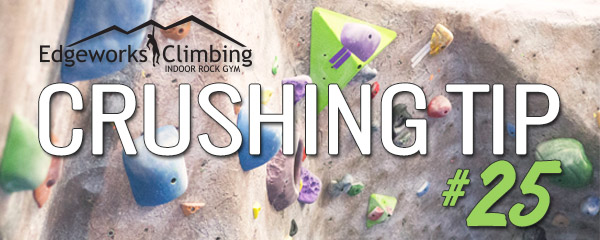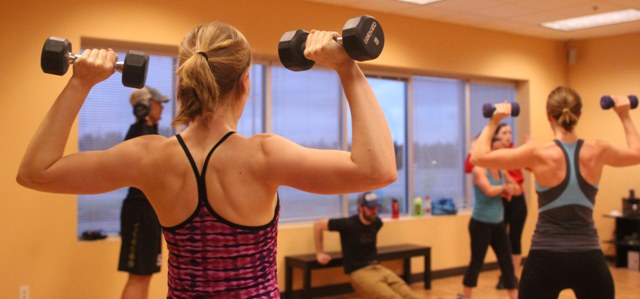Crushing Tip #25
Friday, May 1st, 2015Watch more TV
by Jon Manz


by Jon Manz

by: Marissa Lyons
The term “metabolic training” is thrown around quite a bit in the fitness industry but what does it mean, how does it work, and what does it have to do with climbing? In simplest terms, metabolic training or conditioning refers to exercise methods that will improve or enhance the body’s two main energy systems: aerobic and anaerobic. Use of different work-to-rest ratios during training can call upon these energy systems and cause specific adaptations to improve performance; climbing is a sport that requires use of all three metabolic systems.
Most often when a trainer refers to metabolic training they are referring to high-intensity intervals which target the anaerobic system. While climbing in itself is an effective anaerobic workout it is sometimes difficult to climb routes hard enough, due to technique barriers, to fully challenge your metabolic system and improve your strength and power. Further, the harder and more powerful the route the more often your anaerobic system is needed. Therefore, it is necessary to train your anaerobic system in order to improve your climbing.
Not only is metabolic training important for performance goals, but high-intensity interval training is also the most effective way to burn calories and stay slim. Exercise physiologists have discovered that the traditional long sustained cardio workout only improves the aerobic system while a medium to high-intensity anaerobic workout improves overall metabolism and continues to work long after you leave the gym; often burning extra calories up to two days post workout. By adding full-body interval training to your schedule you will slim down, increase power and endurance. So next time you are thinking of going for a jog, tryout one of our strength classes or ClimbFit workouts instead.
by: Marissa Lyons
There are a lot of ways to climb better, faster and stronger, but one thing that improves climbing without any training is a good pair of shoes!
Beginners typically choose loose-fitting comfortable shoes. But no matter what grade you climb, I recommend you get a high-end pair of shoes that are snug , but not miserably tight. Higher end shoes give you much more precision, and do a better job of allowing you to use all parts of your foot. This is the one and only piece of gear that can actually make a difference in your climbing! Get the best fitting pair of high-end shoes you can find!
Here is a detailed article on how to pick out your first pair of climbing shoes.
Also, for more information on shoes and gear, check out our Tuesday Night Clinic on February 18th with our in-house staff gear guru, Mike Dove, and our friends from Petzl.

by: Jessica Berg
One of the easiest and arguably the most enjoyable ways to improve your crushing capabilities is to eat yummy food! Nutrition can be a confusing topic, but one thing that is clear is that eating a recovery meal after exercise is an important part of training and necessary for achieving optimal performance.
Nutritionists, say that eating a recovery meal no longer than 30 to 45 minutes after exercising will boost metabolism, replenish nutrients and build muscle. Ideally, the body needs about a 3:1 ratio of carbohydrates to proteins after exercise to effectively replenish glycogen stores and to stop the body from producing cortisol, the bodies stress hormone, which can actually cause muscle atrophy.
So every time you climb or work out, try rewarding the body with some tasty food to help rebuild your muscles. While we recommend that you eat something wholesome and delicious after crushing, a recovery meal can be as simple as a protein bar, chocolate milk or a classic PB&J or deli sandwich.
Treat yourself! Your muscles are tired and ready to replenish so you can get crushing.
You’ve undoubtedly heard the advice: keep your arms straight! But, of course, you can’t keep your arms straight the whole time or you wouldn’t be able to flex them to pull yourself upward.
When you’re hanging on holds, indeed, it’s a good idea to keep your arms straight. But the second part of this advice that’s left out is how to begin initiating your upward movement. Typically, beginners will initiate the move with their arms, pulling themselves up. Instead, try to always initiate your upward movement with your legs. Keep your arms straight and move yourself upward by pressing with your feet. Eventually, you’ll have to flex your arms, but try to do so only after you’ve initiated the upward movement with the legs–even if it’s just a little bit.
Teach yourself what this feels like by climbing easy routes in the gym. Hang from straight arms and try to drive yourself upward as far as you can by high-stepping your feet and using only your leg muscles to stand up on every hold.
by: Andy Davis
Do you ever find yourself tapping the wall with your foot in order to stand up? Do you find yourself holding onto holds harder than you need to? Perhaps becoming more adept at shifting your weight might help!
We are incredibly good at shifting our weight when doing activities like walking, running, ice skating, slacklining, etc… What is different about climbing? Well we get to hold onto things with our arms mucking our balance up. At the most basic level what you should be doing while climbing is shifting your weight from foothold to foothold while balancing with your hands. That’s right, not pulling with your arms, just shifting your weight to balance on your feet.
A great way to practice this concept is to get on an easy slab route and try climbing it without hand holds. You can also traverse and practice moving your hips in such ways that you feel balanced at all times with as little weight on your hands as possible.
Good Luck!
Many of us have heard that elbow and shoulder pain associated with climbing is an overuse injury, but what does this mean and why does it happen? An overuse injury simply means that a joint or muscle is working harder than it can handle. Overuse injuries often happen in joints and small muscles due to a plethora of reasons including, insufficient rest, dehydration and movement compensations. If you have experienced shoulder or elbow pain before, you probably have heard that this pain is just a part of climbing, that climbing is hard on the body, and that injury is inevitable. But have you ever wondered why your buddy who climbs the exact same amount as you doesn’t have pain and you do.
The real question is why are your shoulders and elbows working harder than they should be? While overtraining is a legitimate consideration, climbing itself should not inherently cause injury. In fact, climbing is a natural movement for humans; most of us learned how to climb before we learned to walk. Watch your baby videos…you most likely went from crawling to climbing tables and chairs to walking. So, if climbing is natural, why do we have pain? Your elbow and shoulder pain could be due to faulty movement patterns. Seems crazy to think that hip mobility, thoracic mobility and scapular stability can all effect your shoulders and elbows, but the reality is our whole body is connected and if we have weak hips, then we compensate with other parts of our body…such as the shoulders.
How do we know if we have faulty movement patterns? Research has shown that movement compensations and asymmetries can be identified using movement assessments such as the Funtional Movement Screen (FMS), and that likelihood of injury can be predicted based on the results. Further, research has shown that core stability and mobility exercises can be administered to correct weaknesses and significantly decrease the rate of injury.
Several studies have examined the relationship between FMS scores and the incidence of injury. The Functional Movement Screen as developed by Gray Cook consists of seven tests including: Deep Squat, Hurdle Step, In-Line Lunge, Shoulder Mobility, Active Straight Leg Raise, Trunk Stability Push-Up and Rotary Stability. One study measured scores of 46 professional football athletes and concluded that a score of 14 or less (out of 21) on the FMS was associated with an 11-fold increase in the chance of injury and a 51% probability of sustaining a serious injury over the course of one competitive season (Kiesel et al).
Number of Injuries Compared to Scores on FMS:
Another study done on D-II female athletes found that of the individuals who had a FMS score of 14 or less, 68.75% of those individuals sustained an injury throughout their respective competitive season. Additionally, 81.82% of subjects who scored at or below 13 and 48.28% of subjects who scored at or below 15 sustained injuries (Chorba et al).
Research has also been conducted on personnel in physically demanding occupations. A study in the Journal of Occupational Medicine examined Core strength as a model for injury prediction and prevention. The researchers used the FMS to assess core stability and mobility in 433 firefighters and then administered appropriate core training over a 12month period. The intervention reduced lost time due to injuries by 62% and the number of injuries by 42% over a twelve month period as compared to a historical control group (Peate et al).
These studies amongst many others all suggest that an FMS score below 14 puts you at a much greater risk of sustaining an injury no matter what activity you are participating in. Gray Cook explains in his book Functional Movement that humans, for the most part, are not born with these compensations and asymmetries; they develop due to repetitive movements that create poor movement patterns and posture, such as sitting. He also explains that once you have determined a need for intervention based on your FMS score that you can target your weakest link, whether it is a mobility or stability issue, and often all of your FMS scores will go up because the body will readjust via its proprioceptive feedback system. So, before continuing to ice and medicate find a professional who can perform the FMS assessment and see if your elbow or shoulder pain is due to faulty movement patterns. Or, if you aren’t having pain yet, get screened to see if you can avoid the “inevitable” climbing injuries.
Marissa Lyons, ACE- PT, FMS level 1
References
Chorba RS, Chorba DJ, Bouillon LE, et al. Use of a functional movement screening tool to determine injury risk in female collegiate athletes. N Am J Sports Phy Ther. 2010; 5(2); 47–54PMID: 21589661. [PMC free article] [PubMed]
Kiesel K, Plisky PJ, Voight ML. Can serious injury in professional football be predicted by a preseason functional movement screen. North Am J Sports Phys Ther. 2007;2(3):147–152. [PMC free article][PubMed]
Peate WF, Bates G, Lunda K, Francis S, Bellamy K. Core strength: a new model for injury prediction and prevention. J Occup Med Toxicol. 2007;2:3. [PMC free article] [PubMed]
If you want to improve your climbing, there is no substitute for time on the wall. It’s definitely possible to get better without spending every waking moment in the gym, and structured training can go a long way towards making the most of a busy schedule, but the simple truth is the more time you spend climbing the faster you will improve.
If your ability has plateaued but you feel like Training with a capital T sucks the fun out of climbing, this is good news. You can improve without hang boards or campus boards, timed reps or periodized workouts. Keep climbing with your friends, keep trying the routes and problems that look cool and, most importantly, keep having fun. Just do it a little longer or a little more often. You’ll rapidly notice the gains that come from increased fitness and skill reinforcement.